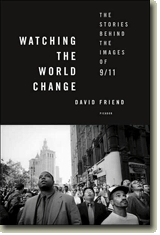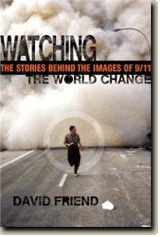November 2008 Archives
« Previous · Home · Next »
November 30, 2008
INSTANT IMAGES & INDIA'S 9/11
The terrorist atrocities in Mumbai this week have been called India’s 9/11. And the characterization seems apt, given the orchestrated carnage, intended body count, and the cold-blooded nature of the attacks.
In terms of media coverage, however, the horrific events seem less like the events of September 11, 2001, and more in line with the South Asian tsunami (2004), the London transit bombings (2005), and the Hurricane Katrina disaster (2005), which turned average citizens into frontline correspondents thanks to the ubiquity of cell-phone cameras, lightweight digital video cameras, and photo-oriented blogs.
Given how rapidly technology has propelled our instant access to images and on-the-fly “eyewitness” accounts by citizens caught up in modern-day disaster, we tend to forget that on 9/11 there was no easy way to stream videoclips, few photo blogs, no camera-equipped cell phones. (As I note in Watching the World Change [page 217], former Paris Match editor Alain Genestar would insist, in 2006: “If 9/11 had happened today, the people inside [the towers] would have taken photographs on their cell phones, from inside, and sent the pictures out [over the Internet].”) It is difficult to fathom or imagine the compounded horror we would have seen, first hand.
In today’s New York Times, reporters Brian Stelter and Noam Cohen make this same point in their article “High-Tech Citizen Journalists Provided Glimpse of Mumbai Attacks.” They write:
"From his terrace on Colaba Causeway in south Mumbai, Arun Shanbhag saw the Taj Mahal Palace & Tower Hotel burn. He saw ambulances leave the Nariman House. And he recorded every move on the Internet.
"Mr. Shanbhag, who lives in Boston but happened to be in Mumbai when the attacks began on Wednesday, described the gunfire on his Twitter feed — the 'thud, thud, thud' of shotguns and the short bursts of automatic weapons — and uploaded photos to his personal blog.
"…The attacks in India served as another case study in how technology is transforming people into potential reporters, adding a new dimension to the news media.…At the end of the day on Friday, CNN’s license to transmit live video in India expired, forcing the network’s correspondents to report via telephone. CNN and other channels in the United States relied on live coverage and taped reports from Indian networks.
"The cameras and phones carried by people swept up in the attacks were not subject to any such rules. Mr. Shanbhag photographed one of the fires at the Taj hotel and the wreckage outside a popular cafe that was attacked on Wednesday and posted them on his Flickr stream. Some people transmitted video from inside the Taj hotel to news networks via cellphones. And reporters used cellphones to send text messages to hotel guests who had set up barricades in their rooms.
"Much of this activity flourished early in the crisis, while there was a vacuum of official information either from government sources or from mainstream media outlets still struggling to understand the extent of the attacks."
Or as Robert Calo of Berkeley's graduate school of journalism school had noted, in a story by the Times’s top media analyst David Carr the week of the 2004 tsuanmi: “If you think back, news gatherers would [traditionally] get the story and then commission a phototgrapher to go and get the pictures. Now we have flipped it around to where reporters are chasing the pictures, trying to create some context for what viewers are seeing.” (Watching the World Change, page 293).
November 22, 2008
PIXEL GLUTTONS
Still photographs and videoclips continue to proliferate, replicate, metastacize, across the Web. We cannot keep track of all the private photo albums that become instantly public, swelling the photo-sharing venues; last night’s party and runway snaps that permeate the paparazzi sites; the plentitude of “Cheese” shots that are perpetually refreshed on MySpace and FaceBook pages.
This month Google announced it was providing low-res scans of millions of photos from the legendary LIFE Picture Collection - and selling digital prints, framed, for $79.99 each. Google Earth, with its satellite images of American property, coast to coast, continues to serve up everyone’s private domains for public consumption. (There is even a mock-Google site that shows various Biblical scenes, as if viewed from a divine perspective.)
Anyone with a libido and laptop can log onto youporn.com, a collection of amateur or professional X-rated videoclips that has a higher weekly viewership than CNN.com. Talk about a hard-core fan base. The short text that accompanies the very first clip up on the site, right now, right this evening – the porn videos are displayed in row after row and page after page – reveals that the clip first went up today and has already been viewed more than 28,000 times, which was the population of the Midwest suburb I grew up in, back in the day. (On the site, there are offers to link up with hotties in my very town; I assume the photos and emails provided are generic, a tease. But the intimate, even oppressive, locality of it – listing my town because the site “reads” my computer’s GPS coordinates – makes me shudder.) I’ll save you - and me - the embarrassment and won’t link to it.
It’s no wonder, amid all this clutter and optical gluttony, that visual taste on the Internet keeps decaying, that obscenity and snuff keep finding wider audiences. Which might account for why a college serial killer would stop in the middle of his spree to go to his local post office to mail off a video suicide note to NBC News. Or why a kid, as happened this week, would videotape his own suicide for the wide Web world to see (and possibly view his act as a cry for help - and phone in and stop him). I cannot bring myself to even search for (let alone watch) the clip, which, like the hostage-beheading videos earlier this decade, marks another nadir in the history of the medium. I’ll save you the horror and won’t link to it.
Like the scientists who harnessed the power of the atom and have been haunted by Pandora ever since, we’ve created, with Web-dispensed imagery, a delivery system that is sometimes too explosive for its own good.
Take a look at the new LIFE search engine on Google. A viewer has to really hunt for the photographer’s credit. It’s as if these decontextualized, low-resolution, tepidly toned pictures were not taken by men and women, but by old mechanical cameras – for electronic computers to view.
Woe, the humanity.
November 15, 2008
TEACHING THE TEXT
Louis Masur is a celebrated historian at Trinity College in Hartford, Connecticut. His most recent book is Soiling Old Glory: The Story of a Photograph that Shocked America. He writes to say that he just finished teaching Watching the World Change to Trinity students:
“Taught your book again this past week -- even better the second time. We went two hours and still had more to say. With twenty minutes to go, I asked them to consider your book as a memoir, and that launched an engaging discussion of the personal and analytical, the autobiographical and historical.
"My students are all doing wonderful projects, and I've sent a number of them scurrying into Civil Rights photography, which cries out for a definitive treatment. I gave them [David] Margolick's piece on Will Counts' Eckford photograph [“Through a Lens, Darkly” from VanityFair.com, about the famous 1957 Little Rock high school photograph] as well as the work of Charles Moore and James Karales.
“…Anyhow, just thought in this season of glorious political renewal I'd say hi and let you know that I'll be teaching Watching the World Change for years to come.”
KUDOS FOR PHOTO EFFORTS

At this year’s Lucie Awards for photography, Terence Pepper and I were named Curators of the Year for “Vanity Fair Portraits: 1913-2008.” The show, also named Exhibition of the Year at the ceremony, is on view through March 1, 2009, at the Los Angeles County Museum of Art. Terence is the curator of photographs at the National Portrait Gallery, London.
As an added bonus, the show’s catalogue won first place in the exhibitions/catalogues category at the British Book Design and Productions Awards.
Hats off to Vanity Fair editor Graydon Carter, who conceived and oversaw the enterprise; Sandy Naire, director of the NPG; Burberry (sponsor of the exhibition's London and L.A. legs); Terence Pepper; the catalogue's designer, Mimi Park; publisher, Celia Joicey; production chief, Martha Hurley; picture editors Betsy Horan and Dana Kravis - and to the scores of photographers whose work is represented on the walls.
Detail above: Gloria Swanson by Edward Steichen, 1924 (c) Conde Nast Publications, Inc./Courtesy George Eastman House
November 9, 2008
WATCHING THE WORLD CHANGE, REDUX
On Friday, I posted the following piece on VanityFair.com. It feels particularly appropriate in the context of this book blog.

Obama’s Leap – Both Quantum and Quaint
Barack Obama’s victory symbolized quantum-leap change. But in terms of the media’s role on election night—and the public’s consumption of that coverage—many elements were throwbacks to a by-gone era.
Granted, the mesmerized electorate was busy multi-tasking in a typical 21st century frenzy. We followed the state-by-state tallies on laptops or BlackBerries as we text-messaged on cell phones as we diddled our remote controls to surf our hi-def monitors, watching out of the corners of our eyes as commentators used touch-screen maps to swoop in on precincts in contested counties.
Even so, there were moments when the victory seemed so special, so transcendent in relation to the times, that the audience shifted to more established, even antiquated media platforms, seeking a sense of community and commonality that is sometimes lost in the disparate niches of the Net. The night of the election, we turned to mass media: election-coverage TV viewership that night—70 million-plus—approached the 80 million that tuned in to prime-time news outlets the night of the September 11 attacks. (On 9/11, an estimated 2 billion people—a third of the planet—watched television news.) People across the country spontaneously flocked to the streets, as they had on V-E and V-J Days, gathering on campus quads and town plazas, in Chicago’s Grant Park and New York’s Times Square, where massive screens relayed images to massive crowds.
There were wonderful anecdotal reports: a small assembly of citizens, many of them African-American, were seen huddled at the Lincoln Memorial, of all places, listening to their radios, of all things. Chris Whipple, of ABC News, points out that at key moments, TV reverted from moving pictures to stills, as if to slow things down in order to preserve and savor the moment. “I found it reassuring,” he says, “that so many of the television news segments that night and the next day relied on still photographs. They switched from video coverage to photojournalism,” echoing that old reliable, the photo essay, as if channeling the spirit of the weekly Life magazine in its heyday.
And on the morning after the election, all across the land, there was a run on newspapers. People wanted to save a tangible record of the day as a keepsake; the fickle flicker of handheld devices and computer screens and plasma TVs just wouldn’t do. History demanded permanence. And the medium that many considered the most likely candidate for life-support had its banner day, quite literally. Newspaper front pages were the hard, irrefutable evidence that on a special, hallowed day, barriers had fallen and a nation had risen up.
In a poignant confluence of old media and new on election night, editor and curator Russell Burrows learned of the passing of President John F. Kennedy’s chief White House photographer, Cecil Stoughton. At 8:10 p.m. that evening, just after many East Coast polls were closing, Burrows sent out a group e-mail to a small circle of friends in the photo community, informing them of Stoughton’s death, at age 88. Among those on his list were eight former White House photographers. “What’s really surprising,” says Burrows, “is that most of them replied within minutes.” These men and women were sharing their condolences, yes. Stoughton had been a giant of another era, and a friend to many. But, at the same time, they were jacked into their laptops, watching the world change.
November 4, 2008
Vote early...
...and often...


